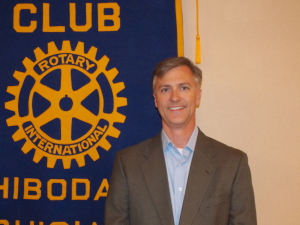Trees – November 18
 On Tuesday, November 18, 2014, the members of the Rotary Club of Thibodaux had the privilege of meeting, once again, Scott Courtright, who spoke to us on trees.
On Tuesday, November 18, 2014, the members of the Rotary Club of Thibodaux had the privilege of meeting, once again, Scott Courtright, who spoke to us on trees.
Mr. Courtright is well-versed in trees as he has earned a B.S. in Forest Management. He is also a licensed arborist and is a member of the Louisiana Urban Forestry Council and the American Society of Consulting Arborists.
Trees have three parts. The crown is the top of the tree and the condition of the crown allows arborists to make evaluations on the health of the tree. The second part is the stem or trunk. It is the most abused part of the tree. The third and final part is the root system. There are anchoring roots as well as fibrous hair roots.
There are many things to consider when one desires to plant a tree. Each tree fits a certain space. One must look at the amount of space allowed to plant the tree as well as factors such as the PH level of the soil, saturation level and the overall expected growth of the tree. An interesting fact that Courtright taught us is that we can determine how far the root system of a tree will extend out in a particular area by multiplying the height of the tree one and a half times.
Trees can be separated into two categories. Trees are native or non-native. Native trees are naturally occurring trees in a particular area. A few examples in South Louisiana are the southern magnolia and the live oak. Non-native trees are not naturally occurring in a particular area. A tallow tree is an example of such. Natives are much easier to obtain and have a higher success rate when planted.
Another important factor to be considered when one desires to plant a tree is to know the planting season. In Louisiana the planting season is from November to March. Thus, now would be the time for all Rotarians to plant their favorite native tree.
